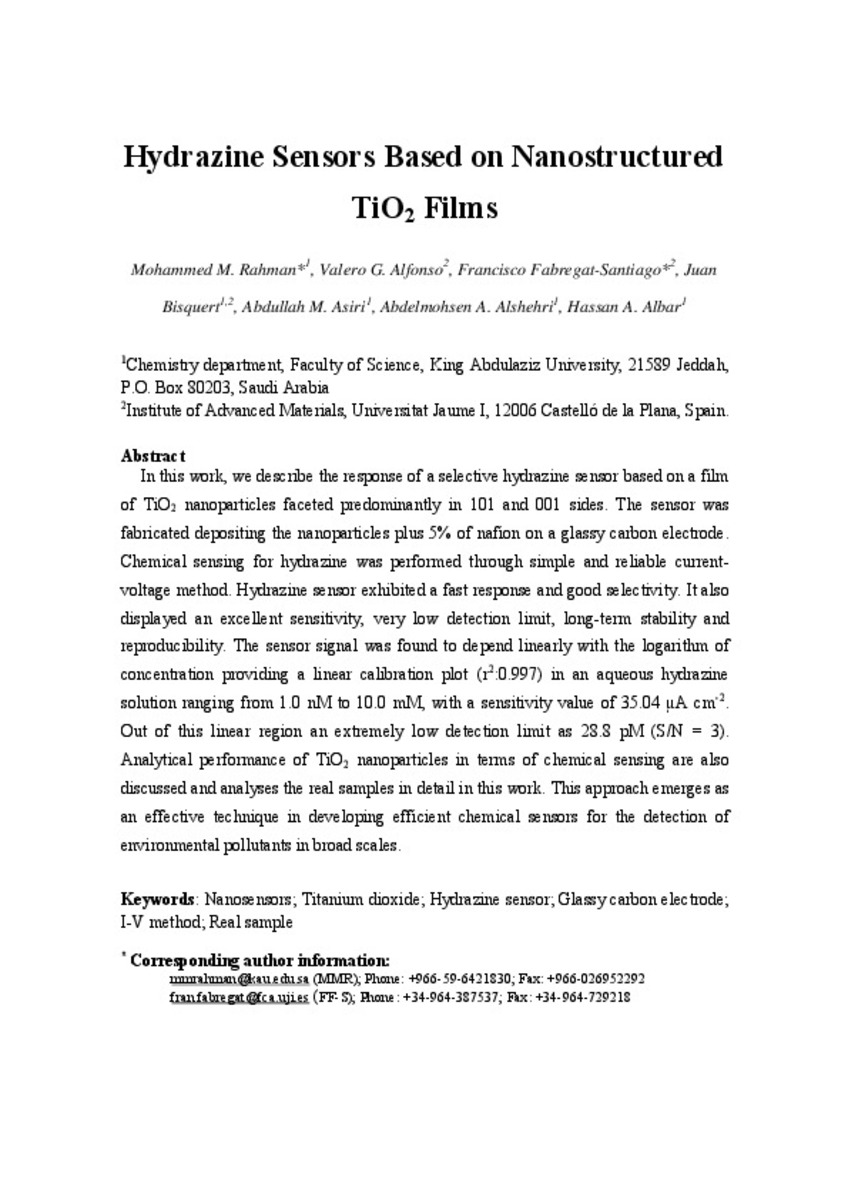Mostrar el registro sencillo del ítem
Hydrazine sensors development based on a glassy carbon electrode modified with a nanostructured TiO2 films by electrochemical approach
| dc.contributor.author | Rahman, Mohammed M. | |
| dc.contributor.author | Alfonso, Valero G. | |
| dc.contributor.author | Fabregat-Santiago, Francisco | |
| dc.contributor.author | Bisquert, Juan | |
| dc.contributor.author | Asiri, Abdullah M. | |
| dc.contributor.author | Alshehri, Abdelmohsen A. | |
| dc.contributor.author | Albar, Hassan A. | |
| dc.date.accessioned | 2017-12-13T12:06:54Z | |
| dc.date.available | 2017-12-13T12:06:54Z | |
| dc.date.issued | 2017 | |
| dc.identifier.citation | Rahman, M.M., Alfonso, V.G., Fabregat-Santiago, F. et al. Microchim Acta (2017) 184: 2123. https://doi.org/10.1007/s00604-017-2228-x | ca_CA |
| dc.identifier.issn | 0026-3672 | |
| dc.identifier.issn | 1436-5073 | |
| dc.identifier.uri | http://hdl.handle.net/10234/170825 | |
| dc.description.abstract | The authors describe a selective hydrazine sensor that is based on the use of a film of TiO2 nanoparticles faceted predominantly at the 101 and 001 sides. The hydrazine (Hyd) sensor was fabricated by depositing the nanoparticles in 5% concentration in a nafion matrix on a glassy carbon electrode (GCE). The sensor exhibits a fast response, excellent sensitivity and good selectivity over 1.0 nM to 10.0 mM. The sensor responds linearly to the logarithm of the concentration of dissolved hydrazine in the range from 1.0 nM to 10.0 mM, with a sensitivity of 35.04 μA.mM−1 .cm−2 . The detection limit is 28.8 ± 0.2 pM (at an S/N ratio of 3) is extremely low. In our perception, this approach emerges as an effective technique for developing efficient chemical sensors for environmental pollutants. | ca_CA |
| dc.format.extent | 15 p. | ca_CA |
| dc.format.mimetype | application/pdf | ca_CA |
| dc.language.iso | eng | ca_CA |
| dc.publisher | Springer Verlag | ca_CA |
| dc.relation.isPartOf | Microchim Acta (2017) 184 | ca_CA |
| dc.rights | (c) Springer-Verlag Wien 2017 “This is a pre-print of an article published in Microchimica Acta. The final authenticated version is available online at: https://doi.org/10.1007/s00604-017-2228-x” | ca_CA |
| dc.rights.uri | http://rightsstatements.org/vocab/InC/1.0/ | * |
| dc.subject | Nanosensors | ca_CA |
| dc.subject | Titanium dioxide | ca_CA |
| dc.subject | Hydrazine sensor | ca_CA |
| dc.subject | Glassy carbon electrode | ca_CA |
| dc.subject | I-V method | ca_CA |
| dc.subject | Sensitivity | ca_CA |
| dc.subject | TEM | ca_CA |
| dc.subject | AFM | ca_CA |
| dc.subject | Detectionlimit | ca_CA |
| dc.subject | Responsetime | ca_CA |
| dc.subject | Water analysis | ca_CA |
| dc.title | Hydrazine sensors development based on a glassy carbon electrode modified with a nanostructured TiO2 films by electrochemical approach | ca_CA |
| dc.type | info:eu-repo/semantics/article | ca_CA |
| dc.identifier.doi | http://doi.org/10.1007/s00604-017-2228-x | |
| dc.relation.projectID | PROMETEO/2014/020 ; NASCENT ; ENE2014-56237-C4-3-R | ca_CA |
| dc.rights.accessRights | info:eu-repo/semantics/openAccess | ca_CA |
| dc.relation.publisherVersion | https://link.springer.com/article/10.1007/s00604-017-2228-x#citeas | ca_CA |
| dc.type.version | info:eu-repo/semantics/submittedVersion | ca_CA |
Ficheros en el ítem
Este ítem aparece en la(s) siguiente(s) colección(ones)
-
INAM_Articles [501]







